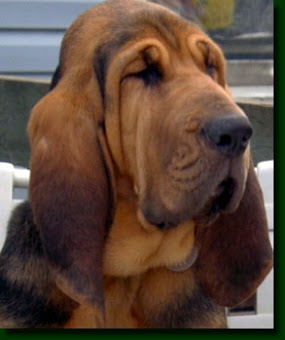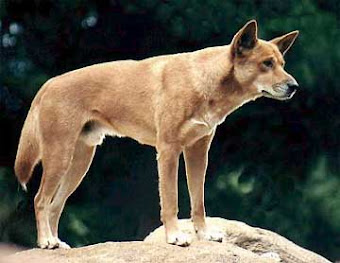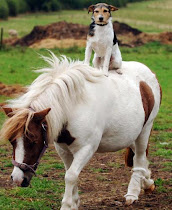 Dingoes cannot bark - but they can howl. Dingoes have in the canine world, capable of rotatation. This enables dingoes to use their paws like hands and turn door knobs. Their ability to go where other dogs can't means dingoes can cause more problems for humans than other wild members of the dog family can. A dingo can turn its head through almost 180 degrees in each direction. Dingoes have permanently erect ears. Dingoes live in Australia and Southeast Asia, mainly Thailand. Australian dingoes are larger than Asian dingoes. The plural of dingo is dingoes, not dingos. Male dingoes are larger than females. Males weigh 26 to 43 pounds (12 to 20 kg) and females weigh 21 to 35 pounds.Domestication of dingoes has been difficult. Dingoes are intelligent animals. They are more independent and harder to train than other dogs. Most Australian dingoes are ginger-coloured or sandy coloured with white chests. There are also dark colored dingoes. Wild dingoes can live for up to ten years but usually live for more like five or six years. Dingoes cared for by people can live up to 15 years or more.Dingoes have larger canine teeth than domestic dogs. Wild Australian dingoes kill and eat prey ranging in size from small lizards, birds and rodents up to sheep and kangaroos. They will also scavenge carrion. At around 8 weeks old, pups are weaned onto solid food, often consisting of regurgitated meatThe days of the pure dingo may be numbered. Dingoes are increasingly mating with feral domestic dogs. Some of the genetically purest dingoes live on Fraser Island in Queensland. Dingoes breed once a year. Australian dingoes mate in autumn. Dingoes' gestation period is two monthsDingoes produce one litter of pups each year. Dingo litter sizes range between one and ten pups. The average number of pups born is five or six. The dominant female dingo kills any pups born to other females in a dingo pack. Pack members help care for the pups of the dominant dingo pair.
Dingoes cannot bark - but they can howl. Dingoes have in the canine world, capable of rotatation. This enables dingoes to use their paws like hands and turn door knobs. Their ability to go where other dogs can't means dingoes can cause more problems for humans than other wild members of the dog family can. A dingo can turn its head through almost 180 degrees in each direction. Dingoes have permanently erect ears. Dingoes live in Australia and Southeast Asia, mainly Thailand. Australian dingoes are larger than Asian dingoes. The plural of dingo is dingoes, not dingos. Male dingoes are larger than females. Males weigh 26 to 43 pounds (12 to 20 kg) and females weigh 21 to 35 pounds.Domestication of dingoes has been difficult. Dingoes are intelligent animals. They are more independent and harder to train than other dogs. Most Australian dingoes are ginger-coloured or sandy coloured with white chests. There are also dark colored dingoes. Wild dingoes can live for up to ten years but usually live for more like five or six years. Dingoes cared for by people can live up to 15 years or more.Dingoes have larger canine teeth than domestic dogs. Wild Australian dingoes kill and eat prey ranging in size from small lizards, birds and rodents up to sheep and kangaroos. They will also scavenge carrion. At around 8 weeks old, pups are weaned onto solid food, often consisting of regurgitated meatThe days of the pure dingo may be numbered. Dingoes are increasingly mating with feral domestic dogs. Some of the genetically purest dingoes live on Fraser Island in Queensland. Dingoes breed once a year. Australian dingoes mate in autumn. Dingoes' gestation period is two monthsDingoes produce one litter of pups each year. Dingo litter sizes range between one and ten pups. The average number of pups born is five or six. The dominant female dingo kills any pups born to other females in a dingo pack. Pack members help care for the pups of the dominant dingo pair.
Dingoes
 Dingoes cannot bark - but they can howl. Dingoes have in the canine world, capable of rotatation. This enables dingoes to use their paws like hands and turn door knobs. Their ability to go where other dogs can't means dingoes can cause more problems for humans than other wild members of the dog family can. A dingo can turn its head through almost 180 degrees in each direction. Dingoes have permanently erect ears. Dingoes live in Australia and Southeast Asia, mainly Thailand. Australian dingoes are larger than Asian dingoes. The plural of dingo is dingoes, not dingos. Male dingoes are larger than females. Males weigh 26 to 43 pounds (12 to 20 kg) and females weigh 21 to 35 pounds.Domestication of dingoes has been difficult. Dingoes are intelligent animals. They are more independent and harder to train than other dogs. Most Australian dingoes are ginger-coloured or sandy coloured with white chests. There are also dark colored dingoes. Wild dingoes can live for up to ten years but usually live for more like five or six years. Dingoes cared for by people can live up to 15 years or more.Dingoes have larger canine teeth than domestic dogs. Wild Australian dingoes kill and eat prey ranging in size from small lizards, birds and rodents up to sheep and kangaroos. They will also scavenge carrion. At around 8 weeks old, pups are weaned onto solid food, often consisting of regurgitated meatThe days of the pure dingo may be numbered. Dingoes are increasingly mating with feral domestic dogs. Some of the genetically purest dingoes live on Fraser Island in Queensland. Dingoes breed once a year. Australian dingoes mate in autumn. Dingoes' gestation period is two monthsDingoes produce one litter of pups each year. Dingo litter sizes range between one and ten pups. The average number of pups born is five or six. The dominant female dingo kills any pups born to other females in a dingo pack. Pack members help care for the pups of the dominant dingo pair.
Dingoes cannot bark - but they can howl. Dingoes have in the canine world, capable of rotatation. This enables dingoes to use their paws like hands and turn door knobs. Their ability to go where other dogs can't means dingoes can cause more problems for humans than other wild members of the dog family can. A dingo can turn its head through almost 180 degrees in each direction. Dingoes have permanently erect ears. Dingoes live in Australia and Southeast Asia, mainly Thailand. Australian dingoes are larger than Asian dingoes. The plural of dingo is dingoes, not dingos. Male dingoes are larger than females. Males weigh 26 to 43 pounds (12 to 20 kg) and females weigh 21 to 35 pounds.Domestication of dingoes has been difficult. Dingoes are intelligent animals. They are more independent and harder to train than other dogs. Most Australian dingoes are ginger-coloured or sandy coloured with white chests. There are also dark colored dingoes. Wild dingoes can live for up to ten years but usually live for more like five or six years. Dingoes cared for by people can live up to 15 years or more.Dingoes have larger canine teeth than domestic dogs. Wild Australian dingoes kill and eat prey ranging in size from small lizards, birds and rodents up to sheep and kangaroos. They will also scavenge carrion. At around 8 weeks old, pups are weaned onto solid food, often consisting of regurgitated meatThe days of the pure dingo may be numbered. Dingoes are increasingly mating with feral domestic dogs. Some of the genetically purest dingoes live on Fraser Island in Queensland. Dingoes breed once a year. Australian dingoes mate in autumn. Dingoes' gestation period is two monthsDingoes produce one litter of pups each year. Dingo litter sizes range between one and ten pups. The average number of pups born is five or six. The dominant female dingo kills any pups born to other females in a dingo pack. Pack members help care for the pups of the dominant dingo pair.
Labels:
but they can howl,
cannot bark,
Dingoes,
unique wrists
Subscribe to:
Post Comments (Atom)












No comments:
Post a Comment